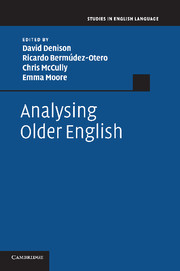Book contents
- Frontmatter
- Contents
- Figures and maps
- Tables
- Contributors
- General introduction
- Part I Metrics and onomastics in older English
- Part II Writing practices in older English
- Part III Dialects in older English
- Part IV Sound change in older English
- 12 Introduction to Part IV
- 13 Syllable weight and the weak-verb paradigms in Old English0
- 14 How to weaken one’s consonants, strengthen one’s vowels and remain English at the same time
- 15 Degemination in English, with special reference to the Middle English period
- Part V Syntax in older English
- References
- Index
15 - Degemination in English, with special reference to the Middle English period
Published online by Cambridge University Press: 05 December 2011
- Frontmatter
- Contents
- Figures and maps
- Tables
- Contributors
- General introduction
- Part I Metrics and onomastics in older English
- Part II Writing practices in older English
- Part III Dialects in older English
- Part IV Sound change in older English
- 12 Introduction to Part IV
- 13 Syllable weight and the weak-verb paradigms in Old English0
- 14 How to weaken one’s consonants, strengthen one’s vowels and remain English at the same time
- 15 Degemination in English, with special reference to the Middle English period
- Part V Syntax in older English
- References
- Index
Summary
Introduction
The principal aim of this paper is to examine the Middle English loss, at dates which differed from one variety to another, of the geminate consonants that occurred between a short stressed vowel and either a following unstressed vowel or a liquid followed by an unstressed vowel, as in [sunnə] ‘sun’ or [applə] ‘apple’. I take the position that such geminates, though undoubtedly long in duration, were essentially clusters. Given, in particular, that in Middle English, as for much of the Old English period, no contrastively long consonants appeared in final position, they are to be regarded as heterosyllabic sequences of identical consonants. In this regard they only differed from the ‘false geminates’ of Present-day English (as in suffixed forms, such as vilely, or in compounds, such as penknife) in that they occurred within the morpheme rather than exclusively at morpheme junctures. Gemination in Old and Middle English should be thought of as a special feature of the phonotactics of the language; and where (as is not always the case) the presence of such clusters served to differentiate lexical meaning in contrast with singleton correlates, such geminates should not be accorded the status of long consonant phonemes. Hence, when such geminates as were contrastive with singletons were lost, it was arguably of no great consequence to the phonological structure of the language. Their demise made for a (by no means insignificant) change in the phonotactic rules of English, rather than for that massive loss in the phonemic inventory which we must suppose if we regard them as long phonemes. Indeed, the fact that such loss was structurally of little importance seems to be tacitly accepted by those historians of the language who, prior to Kurath (1956), gave no extensive attention to or ignored the phenomenon of degemination.
This rejection of the phonemic status of Middle English geminates is one of the several ways in which my approach differs from that of what I take to be the current received view in Kurath (1956), which continues to be cited uncritically in works on Middle English. Indeed, Kurath’s argument is still echoed, despite the fact that one of its major premises, the supposed role played by degemination in the split of former fricative allophones into /f/ : /v/, /s/ : /z/ and /θ/ : /ð/, was long ago shown to be analytically flawed in Sledd (1958).
- Type
- Chapter
- Information
- Analysing Older English , pp. 232 - 244Publisher: Cambridge University PressPrint publication year: 2011

